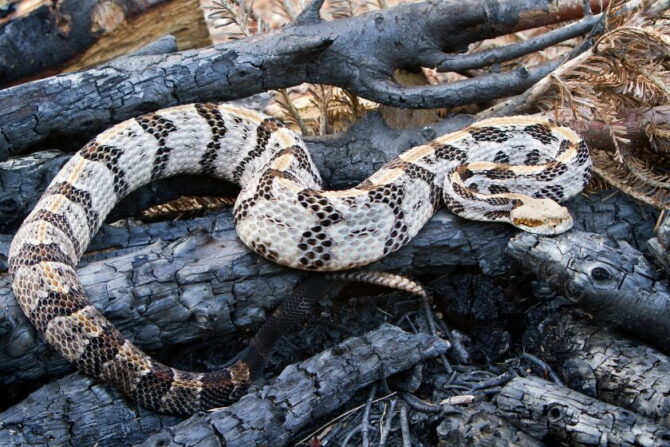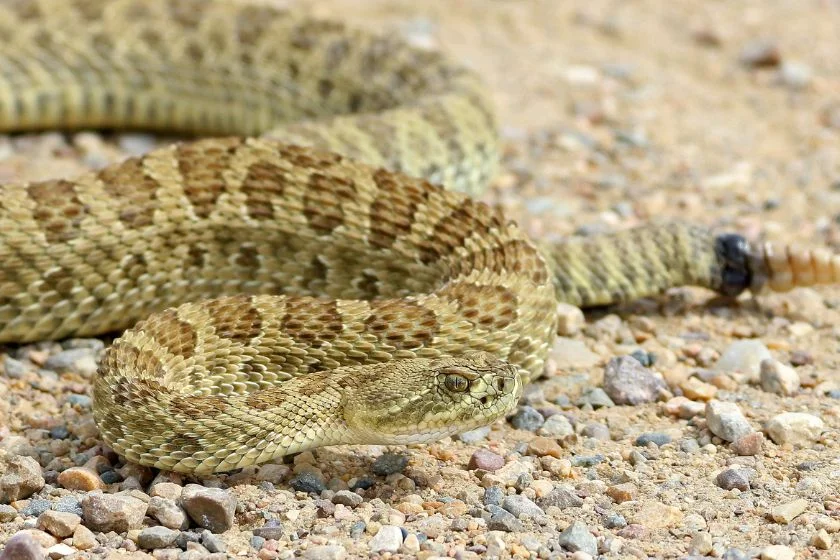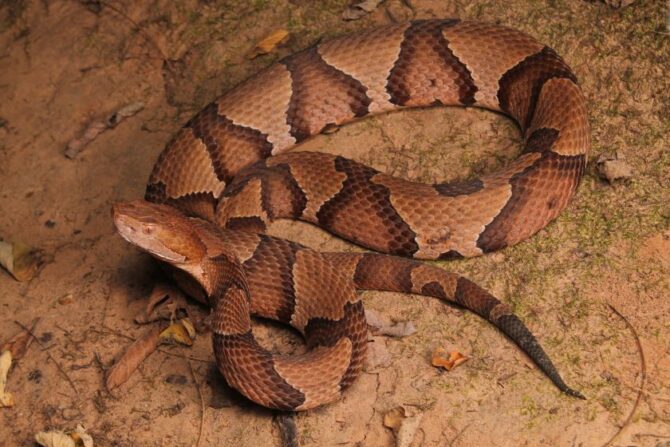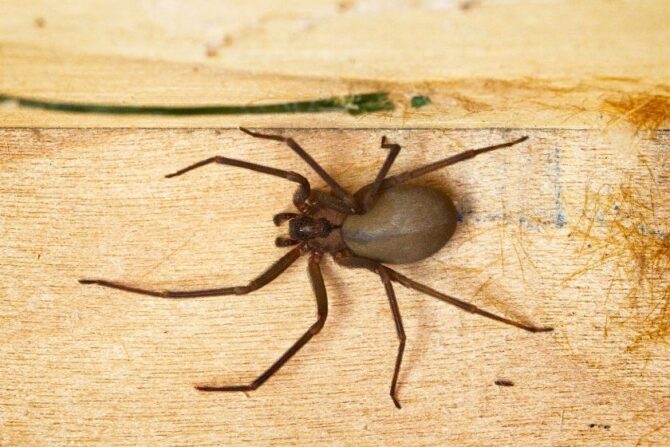The most dangerous animals in Iowa include venomous snake species, spiders, and other creatures like deer, black bears, and more. They are fortified with defense mechanisms that can harm or even kill you.
Iowa, the hawkeye state, is home to about 1,100 wildlife species in the state’s waters and forested inland areas, beckoning millions of tourists to see undomesticated animals in their natural habitats.
However, some of these animals are ferocious and deadly.
Let us walk through the top 9 deadliest animals in Iowa and some safety tips you should know about the wildlife in the area.
What are the Most Dangerous Animals in Iowa?
1. Deer

- Scientific Names: Cervidae
- Classification: Mammal
- Habitat: Rain forests, wetlands, grasslands, deciduous forests, arid shrublands, and mountains.
- Diet: Herbivore
- Conservation Status: Not extinct
Iowa’s most recent deer population estimate is about 460,000.
Sadly, their high population in the state comes with an increased risk of collision, resulting in injuries and fatalities.
Over two deaths were recorded annually between 2010 and 2015, and 69,603 crashes, 4,179 injuries, and 59 deaths between 2005 and 2015.
Deer may seem gentle or have innocent-looking faces, but they are potentially dangerous to humans in confinement or when threatened.
In the wild, bucks in rutting seasons engage in fights looking for does to breed with a surging urge to mate and reproduce.
While humans are not the target, getting caught up in a deer fight could lead to puncture wounds, bruising, other forms of injury, or even death from a deer’s deadly antlers.
Does protect their fawns and could charge at you if you get too close.
Sadly, there have also been reports of hunters killed by the same deer they just wounded because injured animals can be very aggressive.
Therefore, it is best to watch them from a distance.
2. Timber Rattlesnake

- Scientific Name: Crotalus horridus
- Classification: Reptile
- Habitat: Mountainous forests, hilly forests, agricultural fields, hardwood forests, lowland cane thickets, pine forests, swamps, river floodplains
- Primary Diet: Carnivore
- Conservation Status: Least Concern
The Timber Rattlesnake is a venomous pit viper you can find in eastern and southern Iowa. However, it is a rare specie in the state.
This rattlesnake is highly venomous, with an extremely potent, hemotoxic venom enough to kill a human.
Timber Rattlesnakes do not prey on humans but on rodents, birds, lizards, and amphibians.
Nevertheless, they would waste no time defending themselves if they feel threatened or cannot escape your unwelcome presence.
Therefore, a victim should still consider the bite dangerous and seek medical help immediately.
3. Prairie Rattlesnake

- Scientific Name: Crotalus viridis
- Classification: Reptile
- Habitat: Foothills, grasslands, plains, mountains
- Diet: Carnivorous
- Conservation Status: Least Concern
The Prairie Rattlesnake is not common in Iowa but is one of the state’s most venomous endangered snakes.
It is generally not aggressive but will strike when threatened or provoked, such as by unaware hikers.
Prairie Rattlesnake bites are painful and may be lethal to a healthy adult. However, pets may not survive the reptile’s bite.
Victims may have difficulty breathing, impaired vision, or feel nauseated; they may suffer shock, low blood pressure, and internal bleeding in severe cases.
You may argue that rattlesnakes give dry bites, but 75% of their bites are venomous; therefore, you should be careful around the Prairie Rattlesnake.
Like other rattlesnakes, you risk no attack if you steer clear of the Prairie Rattlesnake.
4. Copperhead

- Scientific Name: Agkistrodon contortrix
- Classification: Reptile
- Habitat: Deciduous forests, mixed woodlands, rock outcroppings, ledges, swampy regions, dens, limestone crevices
- Primary Diet: Carnivore
- Conservation Status: Least Concern
The Copperhead is an attractive snake with a bronze-hued head, reddish-tan, copper-colored body (where it undoubtedly gets its name from), and hourglass-shaped stripes on its back.
Nevertheless, it would be best never to translate its artful appearance as beckoning.
The Copperhead ejects a hemolytic venom that breaks down red blood cells.
Its estimated dose is around 100 milligrams, amongst the least potent pit vipers, but its bites can be severe, resulting in nausea, vomiting, diarrhea, or labored breathing.
It will help if you are more careful when hiking around rocky, wooded stream valleys or rocky river valleys in southeastern Iowa.
5. Massasauga

- Scientific Name: Sistrurus catenatus
- Classification: Reptile
- Habitat: Wetlands, prairies, swamps, woodlands, tree roots, rock crevices
- Primary Diet: Carnivore
- Conservation Status: Least Concern
The Massasauga is one of the four venomous snakes you can find in Iowa, spewed across the state’s eastern and southeastern region.
While you might be intrigued by its dark brown blotches, its venom is very toxic, so you must be extremely cautious around them.
Fortunately, there are very few fatality records from the Massasauga’s bites; its teeth are too small to inject enough venom for terrible harm.
Nevertheless, a victim should still consider a Massasauga’s bite dangerous and seek medical help immediately.
6. Black Widow Spiders

- Scientific Name: Latrodectus
- Classification: Arachnid
- Habitat: Crevices, hollow logs, loose bark, holes, burrows, small trees, bushes, woodpiles
- Primary Diet: Carnivore
- Conservation Status: No Special Status
The Black Widow Spider is rare in Iowa, but it is one of the venomous spider species you can find there.
Its venom is neurotoxic, causing chest pain, muscle aches, nausea, muscle tightness, cramping, and a paralysis of the diaphragm, making breathing difficult.
Bites can be fatal but uncommon as only children, the elderly, or the infirm suffer from complications.
Please stay away from dark, undisturbed areas where the Black Widow likes to nest and be careful around outdoor objects that you have not used for a long time.
7. Brown Recluse Spiders

- Scientific Name: Loxosceles reclusa
- Classification: Arachnid
- Habitat: Debris, woodpiles
- Primary Diet: Carnivore
- Conservation Status: Not Extinct
Venomous spiders in Iowa are rare, but the Brown Recluse, like the Black Widow, is one of the state’s venomous spider species.
The Brown Recluse Spider is venomous, with about ten percent of brown recluse bites causing moderate or more significant tissue damage and scarring.
Severe symptoms result in a necrotic lesion where the venom begins to destroy the surrounding tissues, and the wound may expand several inches over the next few days or weeks.
However, there are no verified fatality cases from a Brown Recluse Spider.
Brown Recluse Spider’s bite can cause systemic loxoscelism in extreme cases, a severe illness involving blood clotting disorder and red blood cell destruction.
Sadly, the United States has not approved any effective commercial anti-venom for the Brown Recluse Spider’s bite.
8. Ticks

- Scientific Name: Ixodida
- Classification: Arachnid
- Habitat: Fallen branches, logs, tall brush, grassy areas
- Diet: Carnivore
- Conservation Status: Not Extinct
There are more than twelve tick species in Iowa, and some are dangerous.
Some of these species have harmless bites and do not require medical attention.
However, the American dog tick, lone star tick, and black-legged tick carry tick-borne diseases like Lyme disease, spotted fever, tularemia, tick paralysis, Anaplasmosis, Ehrlichiosis, and Babesiosis.
The Black-Legged Tick is notorious for carrying the bacteria that causes Lyme disease.
Sadly, they are small and difficult to notice until they have fed on your blood and become more noticeable after being attached for some time.
9. Black Bears

- Scientific Name: Ursus americanus
- Classification: Mammal
- Habitat: Pacific Northwest’s forests and mountains
- Diet: Omnivore
- Conservation Status: Least Concern
While Iowa has no black bear breeding population, you can encounter one in the wild as neighboring states, including Wisconsin, Minnesota, and Missouri, have breeding populations.
Black bears are agile, fast, incredible climbers, and fantastic swimmers that can generate up to 800 PSI of bite force and a swipe force reaching 560 pounds.
Putting these figures into perspective, black bears are twice as strong as lions and five times stronger than humans.
Please treat them with great respect and try to avoid them as much as possible. Nevertheless, they will avoid humans, especially if they are well informed of their coming.
Iowa Wildlife Safety Tips
The following tips will help you stay safe as you interact with or encounter wildlife in Iowa.
Drive slow at dusk and dawn
Deer are likely to cross highways at dawn and dusk when you rely on your headlamps rather than natural light.
Therefore, it will be best to put on your full beam headlights to see better, except when there is oncoming traffic.
Drive slowly, and anticipate elks or deer, particularly during the mating season (mid-October to mid-January).
Expect to see more deer or a herd if one crosses the road, and do not swerve to avoid a deer as it could lead to a fatal accident.
Stick to high visibility areas
Watching animals in their natural habitats go about their usual wildlife business is soothing. However, venturing into the wild could be very risky.
Hikers are encouraged to stick to trails, avoiding grasses and overgrown places where snakes and other species can hide.
Watch wildlife from a safe distance
It will be best never to follow or approach wild animals due to their unpredictability and defensive instincts.
Wildlife may quickly feel concerned or threatened and, in their defense, harm people or themselves in an attempt to escape.
Do not try to rescue animals
Reports reveal hunters suffer injuries and fatalities from animals they think they have shot and killed.
While it seems humane to rescue an animal, wildlife is not disposed to domestication and could react if you go close to their young.
Please do not touch or go close to the animal as it may respond instinctively.
It will also be wise to report a lost baby animal or an injured mother to the proper authorities.
Wrap Up
Wildlife in Iowa is beautiful as it is in any other state in the United States and across the world.
However, untamed animals could be ferocious, especially when they sense a threatening action.
Most stay out of humans’ way, and you would be fine if you stay out of their lane and follow the listed guidelines or other state-given instructions.






